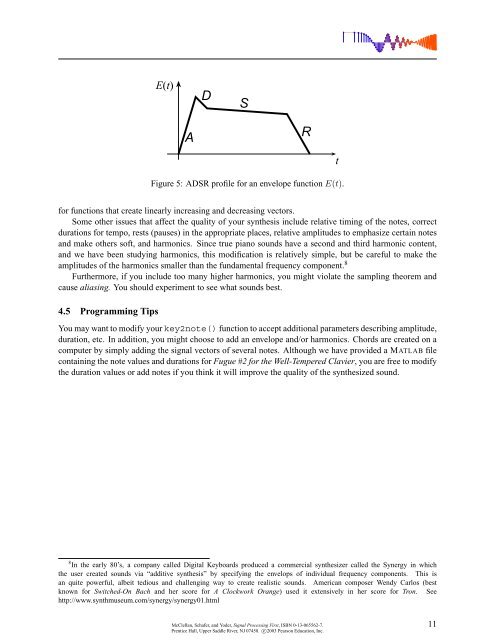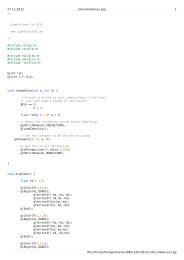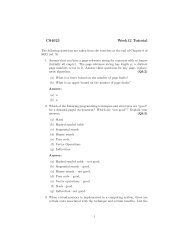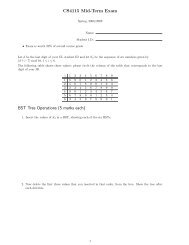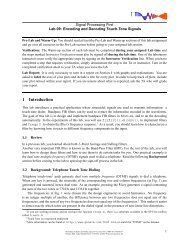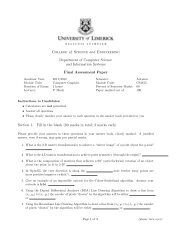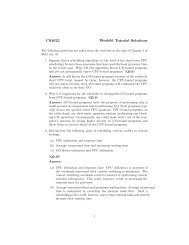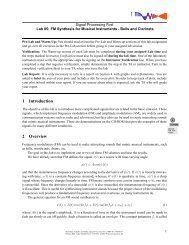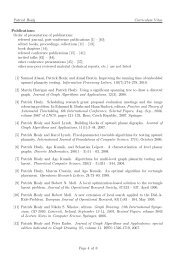4.3.1 Timing<strong>Music</strong>ians <strong>of</strong>ten think <strong>of</strong> the tempo, or speed <strong>of</strong> a song, in terms <strong>of</strong> “beats per minute” or BPM, where thebeats are usually quarter notes. You should write the code so that the BPM is a global parameter that can bechanged easily. For example, you might let the BPM be defined with the statement:bpm = 120;Computer programs which lets musicians record, modify, an play back notes played on a keyboard or otherelectronic instrument are called “sequencer.” 7 The timing resolution <strong>of</strong> a sequencer is usually measured in“pulses per quarter note,” or PPQ. In this lab, we will employ four pulses per quarter note. A real commercialsequencer would have a much higher PPQ to encapsulate the subtle timing nuances <strong>of</strong> a real human playinga real instrument. The starting times and durations <strong>of</strong> notes in the music file provided to you are specified interms <strong>of</strong> “pulses,” so it will be helpful helpful to compute the number <strong>of</strong> “seconds per pulse,” for instancevia:beats_per_second = bpm/60;seconds_per_beat = 1/beats_per_second;seconds_per_pulse = seconds_per_beat / 4;Half notes are twice as long as quarters; eighth notes are half as long. Triplets, as in Jesu, appear to beeighth notes, but should actually be a little shorter—three <strong>of</strong> them should have a total duration equal to aquarter note. If the tempo is defined only once, then it could be changed: for example, setting bpm =240 would make the whole piece play twice as fast.For example, a quarter note is designated by the number 4, an eighth note by the number 8, a half noteby the number 2, a whole note by 1, and so on. When we need a note that lasts longer than a whole notethen we just use a fraction, e.g., 0.5 designates a note that is twice as long as a whole note.Another timing issue is related to the fact that when a musical instrument is played, the notes are notcontinuous. Therefore, inserting very short pauses between notes usually improves the musical sound becauseit imitates the natural transition that a musician must make from one note to the next. An envelope(discussed below) can accomplish the same thing.4.4 <strong>Music</strong>al TweaksThe musical passage is likely to sound very artificial, because it is created from pure sinusoids. Therefore,you should try to improve the quality <strong>of</strong> the sound by incorporating some modifications. For example, oneimprovement comes from using an “envelope,” where you multiply each pure tone signal by an envelopeE(t) so that it fades in and out.x(t) = E(t) cos(2πf key t + φ) (2)If an envelope is used it, should “fade in” quickly and fade out more slowly. An envelope such as a halfcycle<strong>of</strong> a sine wave sin(πt/dur) is simple to program, but it sounds poor because it does not turn on quicklyenough, so simultaneous notes <strong>of</strong> different durations no longer appear to begin at the same time. A standardway to define the envelope function is to divide E(t) into four sections: attack (A), delay (D), sustain (S),and release (R). Together these are called ADSR. The attack is a quickly rising front edge, the delay is asmall short-duration drop, the sustain is more or less constant and the release drops quickly back to zero.Figure 5 shows a linear approximation to the ADSR pr<strong>of</strong>ile. Consult help on linspace() or interp1()7 Popular commercial sequencers include Mark <strong>of</strong> the Unicorn’s Digital Performer, Emagic’s Logic Audio, Steinberg’s Cubaseand Opcode’s Studio Vision.McClellan, Schafer, and Yoder, Signal Processing First, ISBN 0-13-065562-7.Prentice Hall, Upper Saddle River, NJ 07458. c○2003 Pearson Education, Inc.10
E(t)DSARFigure 5: ADSR pr<strong>of</strong>ile for an envelope function E(t).tfor functions that create linearly increasing and decreasing vectors.Some other issues that affect the quality <strong>of</strong> your synthesis include relative timing <strong>of</strong> the notes, correctdurations for tempo, rests (pauses) in the appropriate places, relative amplitudes to emphasize certain notesand make others s<strong>of</strong>t, and harmonics. Since true piano sounds have a second and third harmonic content,and we have been studying harmonics, this modification is relatively simple, but be careful to make theamplitudes <strong>of</strong> the harmonics smaller than the fundamental frequency component. 8Furthermore, if you include too many higher harmonics, you might violate the sampling theorem andcause aliasing. You should experiment to see what sounds best.4.5 Programming TipsYou may want to modify your key2note() function to accept additional parameters describing amplitude,duration, etc. In addition, you might choose to add an envelope and/or harmonics. Chords are created on acomputer by simply adding the signal vectors <strong>of</strong> several notes. Although we have provided a MATLAB filecontaining the note values and durations for Fugue #2 for the Well-Tempered Clavier, you are free to modifythe duration values or add notes if you think it will improve the quality <strong>of</strong> the synthesized sound.8 In the early 80’s, a company called Digital Keyboards produced a commercial synthesizer called the Synergy in whichthe user created sounds via “additive synthesis” by specifying the envelops <strong>of</strong> individual frequency components. This isan quite powerful, albeit tedious and challenging way to create realistic sounds. American composer Wendy Carlos (bestknown for Switched-On Bach and her score for A Clockwork Orange) used it extensively in her score for Tron. Seehttp://www.synthmuseum.com/synergy/synergy01.htmlMcClellan, Schafer, and Yoder, Signal Processing First, ISBN 0-13-065562-7.Prentice Hall, Upper Saddle River, NJ 07458. c○2003 Pearson Education, Inc.11


